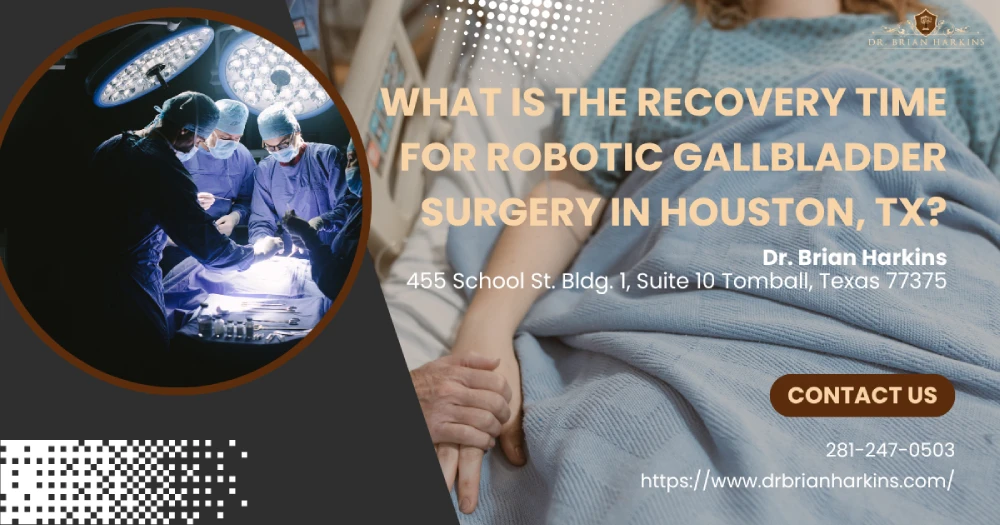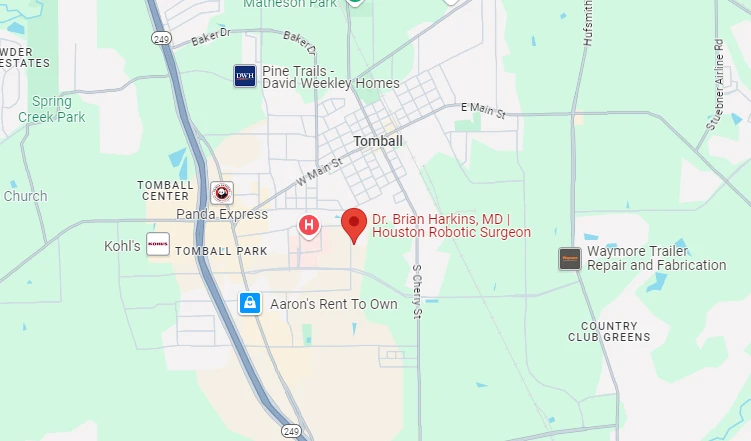
Robotic gallbladder surgery—often performed with the da Vinci Surgical system—is a minimally invasive procedure that delivers a noticeably quicker recovery period than traditional open surgery. During this laparoscopic gallbladder surgery, the gallbladder is removed through a few small incisions in the abdomen, giving the surgeon high-definition control while sparing surrounding tissue. Because the robotic system uses articulating robotic arms that mimic the movement of a human wrist, patients usually experience less discomfort after surgery, a shorter hospital stay, and fewer scars compared to traditional open surgery or even standard laparoscopic surgery. If you're asking, what is the recovery time for robotic gallbladder surgery in Houston, TX, you'll be glad to know most patients return to daily activities within just a few days.
Houston’s dynamic medical landscape combines academic centers, community hospitals, and private outpatient facilities, many of which rely on cutting-edge robotic surgery techniques. This type of surgery offers precision and control unavailable in traditional surgery and can be used for multiple specialties—from general surgery to colorectal surgery—while dramatically shortening downtime.
Although labeled “robotic,” this surgical procedure to remove the gallbladder is still surgeon-driven. The doctor controls wristed instruments from a console, gaining a high-definition view of the surgical site. The robotic system filters tremor and allows 360-degree rotation; the surgery allows the surgeon to maneuver more delicately than with standard laparoscopic sticks, assisting in surgical procedures that demand accuracy near vital ducts and vessels.
Even though everyone’s recovery is unique, Houston’s high-volume robotic programs see predictable milestones. Understanding the recovery timeline keeps you one step ahead at every phase of recovery.
| Timeframe | What You’ll Likely Experience | Recommended Activity |
|---|---|---|
| 0–6 Hours | Awake in recovery; mild incision or shoulder soreness. | Deep breathing; first assisted walk. |
| 6–24 Hours | Discharge if vitals stable; clear liquids, light snack. | Short hallway walks every 2–3 hours. |
| Days 2–7 | Tenderness fades; bloating common. | Return to desk work; avoid lifting >10 lbs. |
| Week 2 | Energy returns; appetite normal. | Drive when off pain meds. |
| Weeks 3–4 | Most resume full duties and exercise. | Increase cardio; light strength training. |
| Month 2+ | Internal healing complete; scars fading. | No restrictions—maintain healthy lifestyle. |
Nurses monitor vitals, manage nausea, and encourage ambulation. Early movement prevents clots, wakes up digestion, and is key to a smoother and more successful recovery after robotic gallbladder surgery compared to traditional open approaches.
Adopt a “walk, rest, hydrate, repeat” routine. Because robotic surgery allows smaller incisions, most patients feel only minimal discomfort after surgery. Still, follow every guideline set by your surgeon to perform a safe recovery at home.
As inflammation subsides, you’ll notice a faster recovery pace than friends who underwent traditional surgery. Continue to protect the surgical area, mind the 10-pound rule, and focus on nutrition that supports liver health.
Once cleared, return to core workouts, jogging, and moderate weights. Ongoing exercise prevents new gallstones in the bile ducts and supports overall health by undergoing robotic gallbladder removal. ---
Obesity, uncontrolled diabetes, and smoking can stretch the recovery period. Addressing these concerns with your healthcare provider to explore pre-hab programs can make all the difference in your recovery journey.
High-volume centers employ ERAS checklists, non-narcotic blocks, and warming blankets. This integrated approach, combined with robotic surgical technology, consistently leads to quicker recovery times compared to traditional open surgery.
Ignoring the “no-lifting” rule or eating high-fat meals can prolong discomfort. Respect the surgical procedure, stick to lean proteins and soluble fiber, and you’ll notice tangible differences in your recovery timeline.
Roughly 80 % of robotic gallbladder surgeries in Houston are same-day discharges. Advanced minimally invasive surgery and ERAS protocols translate into shorter hospital stays, though some patients—especially those with heart or lung issues—may benefit from a 23-hour observation period.
Most patients drive 3–5 days after surgery once they are off narcotics and can twist comfortably to check blind spots. Always confirm clearance with your surgeon to perform this activity safely.
Surgeons recommend waiting two weeks before long trips to reduce clot risk and ensure you’re close to your healthcare team in case of delayed symptoms or incision issues.
For the first month avoid greasy, high-fat, or ultra-spicy foods. These items overwhelm the bile ducts, potentially causing diarrhea during the adjustment phase following robotic gallbladder surgery.
Robotic incisions are tiny and often heal with minimal scarring. Some patients use vitamin E or silicone gel once scabs fall off, but always ask your provider before applying any topical product to the surgical area.
Houston’s Texas Medical Center hosts fellowship-trained hepatobiliary, general surgery, and colorectal surgery experts who collectively perform thousands of robotic cholecystectomies every year. High procedure volume correlates with faster recovery and lower risk of complications. Insurance carriers increasingly cover robotic surgery because it provides minimally invasive care with quicker recovery and shorter hospital stays.
Worked remotely by day three and returned on-site by day six, thanks to early ambulation and hydration.
Stayed overnight due to sleep apnea but went grocery shopping on day five—minus heavy lifting—demonstrating that robotic surgery offers quicker recovery times compared to traditional open procedures.
A diabetic patient who maintained tight glucose control; she walked her dog two miles by week two, underscoring the value of active management and recovery.
Your liver continues to produce bile; it simply drips continuously rather than in spurts. Most people resume their favorite Tex-Mex dishes within a month, though smaller, more frequent meals may ease digestion. Regular movement and a Mediterranean-style diet support lifelong digestive and liver health.
Robotic gallbladder surgery is a minimally invasive, precision-driven solution that provides Houston residents with faster recovery, smaller scars, and fewer complications compared to traditional open surgery. Choose an experienced surgeon, follow ERAS-based guidelines, and stay active yet cautious. With those steps, you’ll return to your normal activities—often within weeks—and experience the future of surgery today.
Most patients resume normal activity in 2–4 weeks, with light tasks beginning within days. A quicker recovery is a key benefit of this minimally invasive surgical approach.
Up-front costs can be slightly higher due to the robotic system, but many insurers in Houston recognize that shorter hospital stays, fewer complications, and quicker recovery times reduce overall expenses. Always check with your healthcare provider and insurance company to understand any out-of-pocket costs.
Yes, conversion is rare but possible if unexpected scar tissue, bleeding, or an unclear anatomy appears. The ability to switch protects patient safety. Your surgeon will explain this contingency plan prior to surgery and obtain informed consent for all surgical options.
Patients receive general anesthesia, ensuring complete unconsciousness, pain control, and muscle relaxation. Modern anesthetics wear off quickly, aiding faster recovery and allowing most individuals to walk within hours of surgery.
Studies show robotic cholecystectomy offers lower bile-duct injury rates and fewer wound infections compared to traditional open surgery. However, no surgical procedure is risk-free. Choosing an experienced surgeon and following post-operative instructions are crucial for minimizing complications.
No. The robotic arms remain outside the body, manipulating surgical instruments inserted through tiny ports. You won’t feel these devices, and after removal, the small incisions are closed with absorbable sutures or surgical glue.
Your surgeon may combine robotic gallbladder removal with pre-operative or intra-operative ERCP to clear ductal stones. Discuss imaging results ahead of time so your care team can coordinate any additional procedures during the same anesthetic session.
Light cardio is safe within two weeks, but high-impact or core-intensive workouts should wait until week four or until your surgeon confirms full internal healing. Gradual progression prevents hernias and protects the surgical area.
Yes. Surgeons often address small umbilical or incisional hernias during the same robotic session, sparing you a second surgery and offering one consolidated recovery period. Confirm eligibility during your pre-operative consultation.
Age alone isn’t a disqualifier. Surgeons evaluate overall health, cardiac function, and pulmonary status. Many seniors benefit from the shorter hospital stays and quicker recovery associated with robotic procedures, but these advantages must be weighed against any chronic medical conditions.


Dr. Brian Harkins is a renowned surgeon specializing in advanced, minimally invasive, and robotic surgical techniques. With a dedication to innovation and personalized patient care, he has transformed countless lives by delivering exceptional outcomes.

I want a website like this, where do i start?